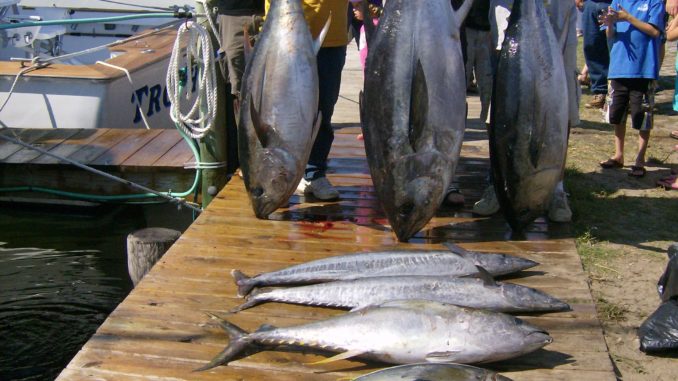
Dr. Craig Brown, chief of the highly migratory species branch of NOAA Fisheries in Miami is an expert on bigeye tuna biology. Here are some of his observations:
• Bigeyes live in all the oceans, but a single stock occupies the entire North Atlantic and South Atlantic; fish make cross-ocean migrations all the time, feed day and night below the deep scattering layer and come up to refresh themselves with oxygen and warm up.
• Bigeyes breed twice a year, from 6 p.m. until midnight in warm water off the coast of Africa and in the western Atlantic off the coast of Brazil and Venezuela.
• NOAA has recorded bigeyes plummeting straight down 1,500 feet to feed and then rocketing upward to the surface, repeating the dive and rise again, and again and again. Bigeyes have a gigantic swim bladder to assist in buoyancy regulation and is rich in blood vessels.
• Bigeyes eat everything when they’re on the surface, but at night their stomachs fill with certain kinds of squid, cuttlefish, shrimp and fish from the oxygen-depleted cold depths below the deep scattering layer. This hypoxic water holds less than 1.5 parts per million of oxygen, and sometime 0.5 ppm. No other tuna can reach this depth or survive this low oxygen level. They’ve been recorded in the Pacific down to 3,000 feet. When they come back up to “sun” themselves, they are warming up and breathing deeply to replenish oxygen to the blood.
• Bigeyes are not overfished. They constitute one of the world’s largest commercial fisheries, with most taken in the Pacific for canning or freezing. They are second in value to bluefin tuna, considerably more valued than other tunas. In the Atlantic, the biggest threats are the Ghanaiian baitboat and purse-seine fisheries that capture them around fish aggregation devices (FADs) constructed and planted specifically to attract tunas, wahoo, and other large, valuable fishes.
• Bigeyes are managed with a 27-inch size minimum (fork length). The ones caught off The Point are almost all bigger than that. There is no daily creel limit, so you can catch and keep as many as you can before you collapse.


Be the first to comment